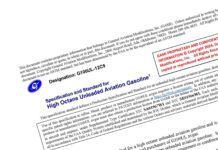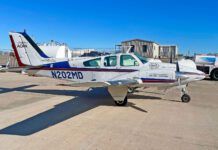The long, torturous road to replace 100LL with an unleaded alternative just got longer and more torturous as the FAA temporarily halted testing on the two leading candidate fuels in May. The agency said its testing revealed differences significant enough with 100LL to obviate further testing.
The upshot: There’s no officially viable replacement for 100LL in sight and the FAA has slipped the promised schedule for an announcement a full year, to December 2019.
What this means for owners is an utter unknown. The EPA is still mulling over what to do about lead in avgas. It has no timeline on ruling against lead. And while the shortfalls in the two candidate fuels are believed to be minor, neither the FAA nor the two companies—Swift and Shell—will comment on whether they can tweak their formulas to comport closely enough with leaded avgas to become realistic, marketable replacements.
Beat Goes On
At AirVenture 2018, a briefing by the FAA and so-called industry stakeholders revealed that the agency’s long-term testing had revealed the two candidate fuels were “exhibiting some differences with potential impacts compared to 100LL.” In mid-May 2018, the FAA concluded that the differences were too great to continue testing, the unstated conclusion being that neither of the submitted fuels would yield a suitable 100LL replacement.
The two fuels got to that stage through a complicated process called the Piston Aviation Fuel Initiative, an organizational framework consisting of FAA and industry technical and testing resources.
PAFI was created in 2014, at which time various potential fuel suppliers were invited to submit candidate fuels. The submissions varied and were wide enough of the mark that several were rejected outright. The two that made it into the second phase of PAFI testing came from Swift Fuel and Shell.
Little technical detail is available on these fuels. Swift came out of the ground a full decade ago, claiming to be a biofuel to be generated from cellulosic feedstock rather than starch feedstock. At the time, Swift claimed its production costs would be cheaper than conventional petroleum-based avgas with its tetraethyl lead octane package. The fuel was described as a binary formula, consisting of mesitylene—also known a trimethylbenzene—and isopentane. These were to be synthesized from bio-derived acetone feedstock.
The fuel has since morphed into what we believe is a more traditional aviation fuel consisting of a high-octane aviation alkylate and some kind of octane package, probably aromatic hydrocarbons. Swift has declined to provide any technical details, but sources familiar with the PAFI testing tell us that Swift fuel doesn’t lack for the required 100 octane.
While Shell is a major player in aviation, it no longer refines any avgas in its own refineries in the U.S. It has, however, imported finished product from a Shell refinery in Europe. Shell’s entry in the PAFI sweepstakes was a surprise because none of the other majors—ConocoPhillips, Exxon Mobil and Chevron—expressed interest in entering PAFI. In conjunction with Afton Chemical, ConocoPhillips did submit an octane additive, but the PAFI requirement called for a finished fuel, not an additive.
Tests Halted
From its inception, the PAFI process has proved opaque, with no meaningful information coming from the companies or the FAA. Our recent queries to the FAA yielded no technical detail on why Swift and Shell fell short. But one source familiar with the testing said one of the fuels caused unacceptable swelling or damage to O-rings and seals, a major worry for a replacement fuel. Based on a conversation with one of the early testers of the fuel, we believe this to be the Shell entry. It also reportedly caused paint damage.
The Swift entry is heavier than conventional avgas and has higher energy content. While the weight may not be a deal breaker, the higher heat content may suggest there are too-rich issues with Swift that the FAA is uncomfortable with. Again, the FAA wouldn’t confirm this, but one of the testers said one of the fuels had “minor operational issues.”
Unknown is whether these problems can be sorted out, the formula tweaked and resubmitted. In a response to our queries to the FAA, the agency said this:
“Under the Co-operative Research and Development Agreement approach that we have just announced, the FAA will only be able to conduct a limited number of engine tests on these fuels due to funding and resource/time limitations. Our focus will be on detonation, performance and operability testing using the PAFI test protocols to assess the maturity and potential viability of the fuels to advise potential follow-on test and approval activity.
These tests are a small subset of the extensive engine and aircraft testing being completed within the PAFI R&D test program. One of the most beneficial outcomes of the PAFI effort to date has been the development of a validated and industry coordinated set of test protocols to evaluate unleaded fuels for aviation applications.”
Translated, this means that Shell and Swift are invited to tweak their formulas any way they like and resubmit to a more abbreviated PAFI testing protocol. Tellingly, the FAA is also inviting other companies to enter the PAFI process, although it’s unclear how these fuels will be qualified in less than a quarter of the time it took to get this far.
When asked if the FAA has given up on finding a drop-in replacement fuel, the agency responded: “No. A better term to use in this case would be ‘transparent’ versus ‘drop-in.’ The term drop-in would imply the fuel or fuels fit within the existing ASTM D910 fuel specification in all aspects. Going forward at multiple levels we’ve anticipated that the new fuels may need to fit under different specifications.”
Unanswered is whether such “different specifications” would require mitigations such as changes to aircraft fuel systems, ignition systems or modifications to ignition. Although this seems unlikely, no one is saying it’s impossible.
GAMI In The Wings

Hovering outside the PAFI process is General Aviation Modifications Inc., the Ada, Oklahoma, company that has had a fuel called G100 under continuous testing since 2011. GAMI has pursued an STC process rather than the formal FAA certification path represented by the PAFI process.
Although the FAA and segments of the industry resisted the STC idea at nearly every stage, GAMI’s George Braly said in early June that the company is nearly done with its testing. Braly said the company needs to complete one more 150-hour test run on a Cirrus engine, flight testing on a Lycoming IO-540K-equipped Lance and operational testing on a Cherokee. That work could be done as early as the end of the year or early 2019.
Having seen the other two fuels come up short, at least temporarily, the FAA recently courted GAMI to submit G100 for the revised and abbreviated PAFI. Braly says GAMI isn’t interested because PAFI is cumbersome and it doesn’t allow adjusting the fuel formulation during testing. “That’s the whole point of science,” Braly says. If the majors, save for Shell, were standing by awaiting a solution, they’ve apparently noticed G100. GAMI is in discussions with refiners—they won’t say who—to blend G100 under license.



And blending is the apt word. Like the Shell fuel, G100 requires a base stock of high-quality aviation alkylate, which is then dosed up with GAMI’s proprietary aromatic octane package. As such, the alkylate can be sent to any terminal—probably by rail—and splash blended with the octane package.
GAMI is thus far the only company to put an estimated price on its fuel. At the terminal dock, Braly estimates it will cost between 40 and 80 cents more than current 100LL, meaning about that range retail at the FBO or self-serve. “But not less than that,” Braly adds.
To use G100, pilots will need the STC, which GAMI hopes to provide for free as a simple download. The downside of the STC approach is that not every engine and aircraft combination will be initially covered, thus no fleetwide approval. Braly believes the approvals will eventually be expanded to cover all but a small portion of the fleet.
Outlook
The FAA told us suspension of PAFI testing and extension of the R&D “should bring confidence to the marketplace and owner-operators that we are working hard to ensure the fuels within PAFI are rigorously evaluated and that we are working to evaluate all viable unleaded replacements for 100LL.”
We think the reverse is true. Following the testing suspension announcement, a poll conducted by our sister publication, AVweb.com, found that 22 percent of respondents were worried by the announcement and another 40 percent said they were concerned. Only a quarter said they weren’t worried at all.
By our estimate, the avgas market may be worth as much as $200 to $300 million in profits, given the exceptionally high margin the product enjoys for refiners. That’s too much business to simply abandon; it’s just unclear at this juncture who’s able—or willing—to seize the opportunity.




